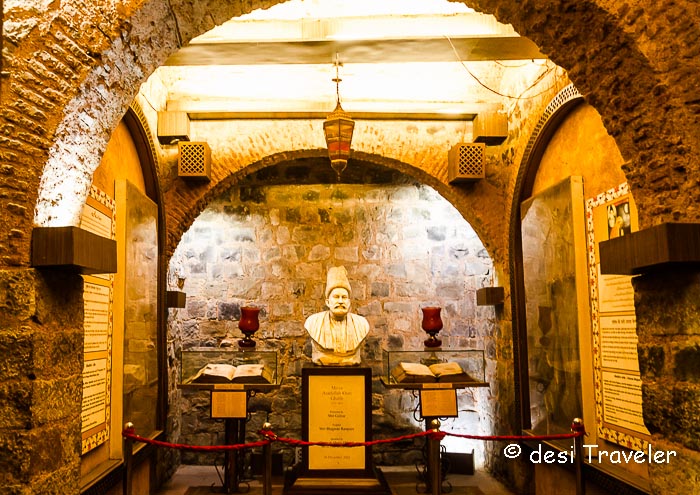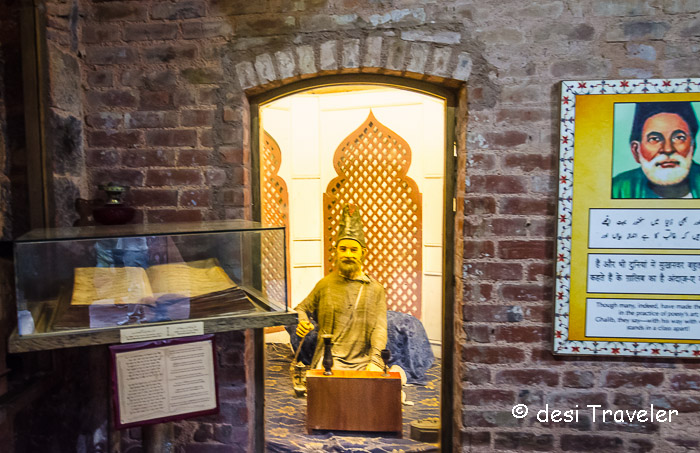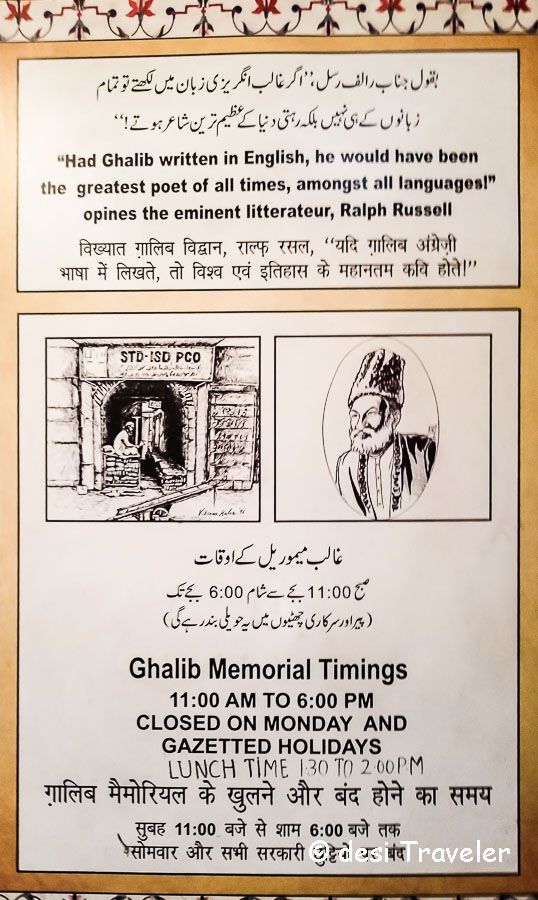desi pays homage to favorite poet of Delhi at Mirza Ghalib Ki Haveli
This post is dedicated to Mirza Ghalib and his fans. A recent visit to Mirza Ghalib’s Haveli in Gali Qasim Jan, Ballimaran, near Chandni Chowk in Old Delhi took me back to centuries and to an era when poets ruled hearts of people, while the Emperors struggled to save their fading glory.
We were introduced to Ghalib in childhood form movie songs from Black and White era like
Nuktachi Hai Gham-E-Dil Usko Sunaye Na Bane
Kya Bane Baat Jahan Baat Banaye Na Bane
Maein Bulata To Hun Usko Magar Ae Jazbaa-E-Dil
Uspe Ban Aaye Kuch Aaisi Ke Bin Aaye Na Bane
Bojh Woh Sar Pe Gira Hai Ke Uthaye Na Uthe
Kaam Woh Aan Padha Hai Ke Banaye Na Bane
Ishq Par Zor Nahin Hai Yeh Woh Aatish `Ghalib’
Ke Lagaye Na Lage Aur Bujhaye Na Bane
Then came the still fresh in my memory TV Serial on Mirza Ghalib where Naseeruddin Shah brought him to life on the small screen while ghazal maestro Jagjit Singh rendered his honey smooth voice to the poetry of the best known Urdu poet of all time. But Ghalib was not always popular, his career as a poet started with a lot of struggle for acceptance. Let me give my personal understanding of Ghalib’ life here that I remember from the TV serial and tales heard from some old Dilliwalas. Take it or leave it but this is desi version of Mirza Ghalib’s life and time, simplified for the times of storytelling in 140 characters.
Ghalib was the quintessential outsider, the migrant who moved to Delhi, Ghalib whose ancestors descended from Aibak Turks, moved to India from Samarkand. But Ghalib was born in Agra, that town abandoned by Shahjahan in favor of the new capital that we know today as Old Delhi.

Mirza Ghalib the poet who still rules our hearts <3
This was the age of decline of Mughal Empire desperately trying to cling to its earlier glory by holding mushairas (Poetic discourses) within the four walls of the red fort, beyond whose boundaries the diktat of the last Mughal Bhadaur Shah Zafar lost all vigor.
Ghalib comfortable with the emerging lingua franca Urdu, had to learn court language Persian but always felt more at home in the language of the man on the street.
All his attempts to mingle with the debonair but fast decaying Dilli Durbar failed for Urdu was not considered to be a language of the elite. But what was rejected by the coterie in the Mughal court was gulped down by masses thirsty for poetry penned in their language. Hence while his contemporaries were busy looking for alms from the bankrupt Emperor, Ghaib will sit with his gambling and drinking buddies and recite his poetry to anyone who cared. And cared they did, soon his ghazals ruled the hearts of Dilliwalas and Ghalib which means – all-conquering, superior, most excellent, no longer needed court’s nod to validate his stature as a poet. While the Mughals soon lost the last vestiges of their throne and the last Mughal Bahadur Shah Zafar was banished to Burma, Ghalib’s ghazals were soon heard in every nook and corner of Delhi from the Kothas of Natch Girls to the mehfils in the Kothis of the nobles who had nothing better to do than remember the good old days and recite to poetry. The golden age of the once mighty Mughals was gone forever, but the golden age of Urdu poetry has arrived. Just as the Mughal empire was declining Urdu poets like Mohammad Ibrahim Zauq and Ghalib were taking center stage outside of the court and reaching out to the people on the streets.
Long gone are the Mughals, the British and others who tried to rule Delhi, but the favorite poet of Delhi- Mirza Asadullah Baig Khan- Ghalib continues to rule the public imagination and his former home is now a pilgrimage point for connoisseurs of Urdu Poetry.
During a photo walk in Chandni Chowk, I visited the narrow lanes of Ballimaran where Mirza Ghalib once lived. His former home’s ground floor in Gali Qasim Jan in Ballimaran is now restored as a Ghalib Memorial and is open to visitors from 11 am to 6 pm on all days except Monday and Gazetted Holidays.
The Ghalib memorial houses some artifacts from that era, a bust of Ghalib, and Mirza Ghalib looks at you from the walls. In today’s selfie-obsessed world a few visitors were seen clicking themselves with Mirza Ghalib.
The old haveli of Ghalib is now decked in colorful drapery and chandeliers to recreate the era of Mughals when noblemen would sit together and listen to poetry when not busy with wars.
I have missed Haveli of Mirza Ghalib during my past photo walks in Chandni Chowk in Old Delhi, but this time I was determined to not miss this historically important building. Not only for poetry connoisseurs but anybody interested in the heritage of Delhi should visit Mirza Ghalib Ki Haveli in Gali Qasim Jan (a distant relative of Mirza Ghalib by marriage) in Ballimaran.
How to reach Mirza Ghalib Ki Haveli in Ballimaran Old Delhi: Well Ghalib himself has given the address in his ghazal:
Ballimaraan ke mahalle ki wo pecheeda daleelon ki si wo galiyan
Saamne taal ke nukkad pe batero ke qaseede
Gurhgurhati hui paan ki peekon mein wo daad wo wah-wah
Chand darwaaze par latke huye boshida se kuch taat ke parde
ek bakri ke mamiyaane ki awaaz
Aur dhoondhlayi hui shaam ke be-noor andhere
Aise deewaron se moonh jor kar chalte hai yahan
Churi-waalan ke katri ki bari bee jaise
Apni bujhti hui aankhon se darwaaze tatole
Isee be-noor andheri see gali qaasim se
Ek tarteeb charaghon ki shuru hoti hai
Ek quran-e-sukhan ka safa khulta hai
Asadullah Khan ‘Ghalib’ ka pata milta hai.
Well I am not qualified to translate this for you but still try to summarize how to find Mirza Ghalib’s Haveli in Ballimaran.
Here is what Ghalib says and please forgive me in advance booking only for any mistakes in the translation of the poetry jee
In the complex confusing arguments sort of by lanes of Ballimaran,
Opposite the wood shop ( Taal ) people talk about partridge games (Partridge fights was a popular time pass in those days).
You will hear people applauding and cheering, over beetle juice filled mouths,
Here on a few doors you will find Jute curtains,
As you hear a goat making some painful sound,
In the evening haze, as the light fades, darkness clings to the walls,
Just like the old lady from the bangle market (chooriwalan)
Who can barely see, tries to figure out the doors by her hands,
In one such dark street by name of Gali Qasim, where a row of lamps starts,
You find a new pious book of poetry begins,
Here is where you will find the address of
Asadullah Khan, “Ghalib”
Phew!! Well that was quite a brain twister for me, but you get the gist. Though to be totally fair to Ballimaran, the Ghalib Ki Haveli is not actually in a very dark lane but on a major artery and the outside is very well-lit. On the other hand I found the interiors of the Ghalib Ki Haveli very dimly lit even with a sunroof letting in some direct light from the top. But the caretaker at the haveli switched on the light and we could see around the haveli.
You find his couplets written on the walls along with his portrait.

A Bust of Mirza Ghalib At Ghalib Memorial Gali Qasim Jan Ballimaran Old Delhi

Some Ghalib Memorablia at Ghalib Ki Haveli, along with his poetry
Even with all the colorful drapery around you, somehow I could feel the pain and gloominess that you find regularly in Ghalib’s poetry.

“No Taat Ke parde” at the Ghalib Ki Haveli, but even with these colorful drapery you can feel the pain of the poet
I wanted to spend some more time at the Haveli to take some more pictures, but had to respect the group and leave. But I am sure I will return again and soak in the era that the Archeological Survey of India has tried to create in the former home of Delhi’s favorite poet.
Finally before I end this post enjoy some of his poem and in his own words the reason for his fame. At no point did Ghalib tried to hide his pain and his chosen life/lifestyle to drown his pain due to loss of his children, his struggle to be accepted ( at-least in initial days before he became famous) by the Mughal Court.
Hai aur bhi duniya mein sukhanwar bahut ache
Kehte hain ke ghalib ka hai andaaz-e-bayaan aur.
(There are many good poets in the world, but they say Ghalib’s style of penning a poem is unique )
And he jokes about his infamy due to his lifesltye of gambling, drinking and as per some scholars fondness for all things taboo for a pious man
Ho goya koi aisa bhi jo Ghalib ko na jaane,
Shayar to who achha hai, mager badnaam bahut hai.
(Is there anyone who isn’t aware of Ghalib? He is a good poet, but pretty infamous).
For those of you who prefer to find Ghalib Ki Haveli using Google map please follow this link and map given below from Chandni Chowk to Ghalib Ki Haveli, Gali Qasim Jan, Ballimaran

Dear Readers, if you are in Chandni Chowk in Old Delhi, do visit the former home of the beloved poet of Delhi, who started as an outsider but slowly captured the imagination of not only Delhi but the Indian Subcontinent and even today is the most read, quoted, recited and blogged about Urdu poet from India.
Do check my recent post below about
Haveli Dharampura a Heritage Haveli Hotel in Old Delhi, with excellent view of Jama Masjid of Delhi and Red Fort from roof top. They also have 13 well done room if you want to stay in a Heritage Haveli of Old Delhi.
If you have liked reading the post please feel free to subscribe by email and like it or share it with your friends on Facebook, LinkedIn, Instagram, twitter and Google+ .
I promise that I will not sell, rent, or donate your email to anybody
🙂 🙂 🙂

we are planning to visit Delhi and i too curious to see Mirza ki Haveli…:)
Have a great trip, do share your experience
What an evocative post! Pure gold it was to read the shayris of Ghalib with accompanied photographs of his former home.
Sigh, I have been guilty of tasting the local delights when in Chandni Chowk in Delhi. Definitely this winter, I shall walk to this place!
Thanks for this fantastic blog post 🙂
Hi Shubham: So glad you liked this post..and I am sure you will love visiting it 🙂
Hi, I stumbled to your blog via Zauq’s shaiyari ….somebody posted that as a reply on my blog and I searching for more shaiyari and landed here 🙂
After going through this post, I have made up my mind to def visit Ghalib’s haveli on my next trip to Chandni Chowk. I love going there.
Hi Priyanka: Welcome to desi Traveler. I am glad you want to visit “Mirza Ghalib Kee Haveli”, do share your experience of the visit.
Wow.. such a nice recount. I have been to Delhi so many times but have never really been a fan of the city. I guess, it is time for me to visit the city with a new set of eyes, new perspective.
Thanks a lot Deepika, I am sure you will soon get to visit Mirza Ghalib ki Haveli and other nuggets in Delhi…
Amen! 🙂
I listen to Ghalib’s poetry in Gulzaar saab’s voice morning to evening while at work, 4 out of 5 working days at-least.
Ghalib’s haveli and Ballimaaran ki galiyan are the places I really want to walk and see. Jopefully the next time I am in Delhi!
We will explore together… give me a buzz when you are in this part of the country… 🙂
Thank you sir, that would be awesome. Would sure ping you next time I am there.
A lovely colorful place.
Feeling quite content seeing the realistic images.
thanks Indrani.. do visit when you are in Delhi next time…
Well…mesmorising!!… Very nice story on this poet… if I ever want to go to Delhi I am sure you can provide information, where to go and how and things… and also details about tiger survey, lots of tiger awareness is there in your blogs. Goodday… yes the poet really captured the heart and fancies of people.
Thanks Maria…
the haveli is really beautiful and one of its kind.. I missed the chance to visit it ,hope I can be there soon and see the rare beauty and have the pleasure to hold memories of such a wonderful place.
Thanks..do visit Mirza Ghalib Ki Haveli next time you are in Old Delhi
There is something about visiting a place where a poet/writer lived and seeing where he sat down to write and wondering what effect that atmosphere must have had.
After your next visit, I’m sure you’ll bring back the minute details about the haveli. 🙂
I am longing to visit again…
Congratulations ! Your blog post has been selected for Spicy Saturday Picks of 25th July 2015 at BlogAdda. You can check here: http://blog.blogadda.com/2015/07/25/spicy-saturday-picks-25th-july-2015
Thanks Blogadda…glad you liked the same…
Great tour of the haveli.
I never visited there but heard many times about this.
Do visit it next time you are in Chandni Chowk…
Thanks a lot for this lovely pilgrimage.
Thanks and Your are welcome … 🙂
Hi. This is an excellent post and your entire blog is very engaging and informative. We at Ivyclique are looking for writers like you to contribute to our site and grow our network of like-minded bloggers. Ivyclique is India’s first user generated content sharing and publishing platform that has over 80 high visibility areas of interest. We invite writers from all over the World Wide Web to share their ideas and thoughts on various topics through our platform. Check us out at Ivyclique.in and log on to get started. We hope to see you there!
Thanks a lot will sure check…
I love this post Prasad…wish I could have also joined in like Mridula did!
Thanks Sid…ping me next time u plan to be in NCR and we will plan a Sid Special…. 🙂
thanks for the detailed post on Ghalib. I look forward to visiting this place.
Thanks a lot Kalpana… I am sure you will like Ghalib Ki Haveli…
This was such an interesting read!
If you can get past the chaos and madness of Chandni Chowk, there’s no place like it. Every gaali, every haveli has a story to tell.
Thanks a lot Purba.. so true…and each time I learn a new story…
and what a wonderful homage this is 🙂 sharing it…
A co-blogger – Manish Purohit has written extensive posts on Ghalib… you may wish to have a dekho… Cheers Prasad…
Thanks Archana, will sure check it out..
This brought back memories of my last visit to the haveli! Have shared them here –
http://www.frommywindowseat.com/2015/01/mirza-ghalibs-haveli.html
http://www.frommywindowseat.com/2015/01/mirza-ghalibs-memorabilia.html
Cool..good to know that you are also a fan of Mirza Ghalib
Beautifully said. What a great poet, what a great tribute. It was a wonderful walk. Thank you!
Thanks a lot Deeba… thanks for joining the walk…
It was fun to do this walk with all of you. And yes, I too want to go back!
Such are the charms of Chandni Chowk that we all want to go back.. thanks
I have faded memories of that serial. Thanks for sharing this info. I have to visit this place when I am in Delhi.
I am sure a poetry aficionado like you will appreciate visit to Mirza Ghalib Ki Haveli
This is amazing post, I loved it so much, this is my dream to visit Haveli of Mirza Ghalib Sahab, and these beautiful pictures takes me more closer to this wonderful poet. Thanks a lot for share.
thanks a lot… and welcome to desi Traveler